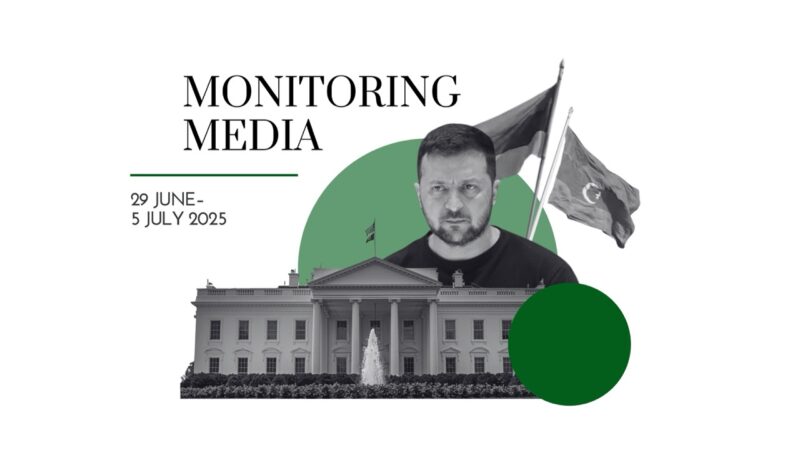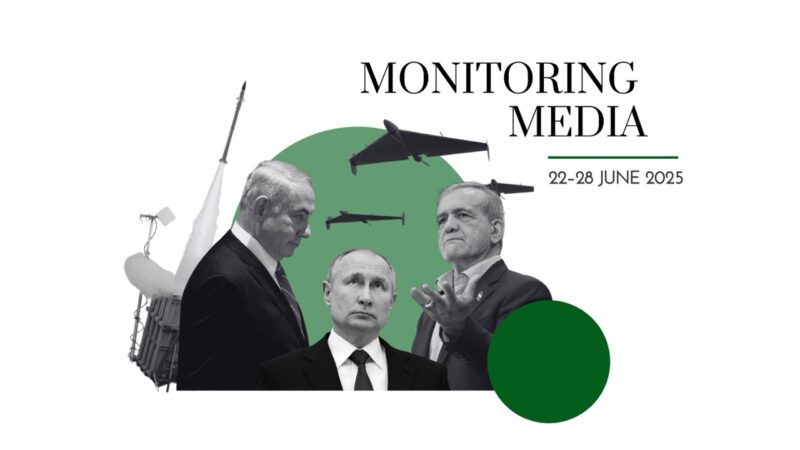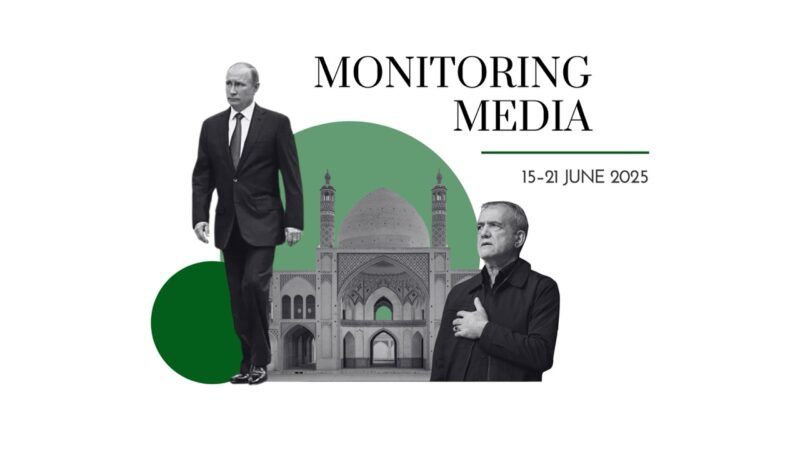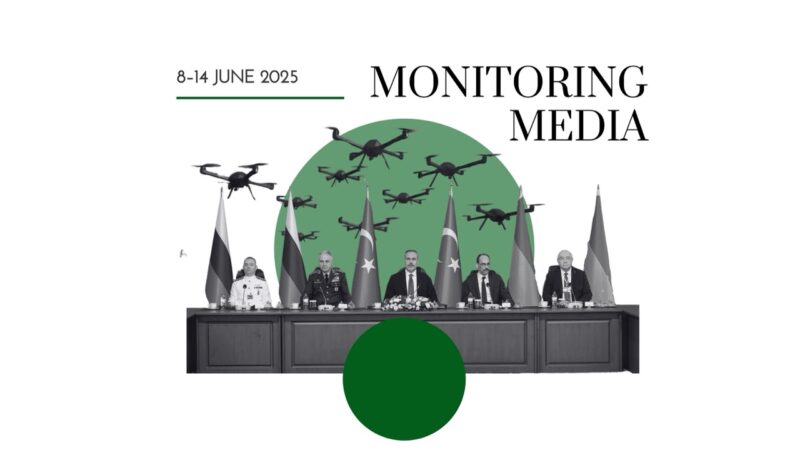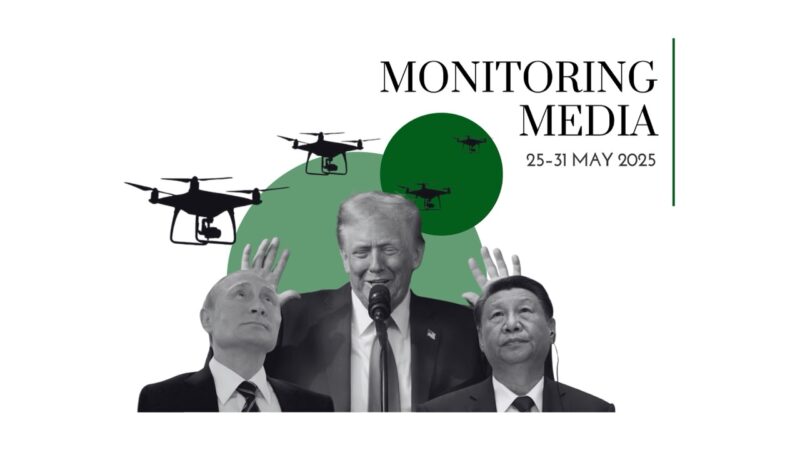Ukrainian sea drones set benchmark for future naval warfare

CIUS weekly report on media coverage of Ukrainian affairs, 3–9 December 2022
Three publications (The Economist, The Atlantic, and The National Interest) were selected to prepare this report on how the situation in Ukraine has been portrayed in the press during the past week (3–9 December 2022). The sample was compiled based on their impact on public opinion as well as on their professional reputation, popularity among the readership, and topical relevance. These three publications represent centrist and conservative viewpoints on the political spectrum.
This report covers only the most-read and relevant articles about Ukraine, as ranked by the respective publications themselves in the past week. Its scope covers promoted articles on home pages and articles from special sections on Ukraine, with the hashtag #Ukraine, from the paper editions of the publications, and about Ukraine from opinion columns and editorials.
Topics featured in the selected articles:
- Ukraine’s current affairs: Ukrainians are having a hard time enduring winter with electricity shortages; Ukrainian army defends heavily assaulted Bakhmut with all the forces that it can muster; Ukraine’s sea drones could revolutionize future naval battles;
- The world and Ukraine: Taiwan today underestimates the threat from China, the same as Ukraine underestimated Russia before 2014; India remains neutral in the Russo-Ukrainian war as this is in their national interest;
- Russia at war: Russians commit war crimes in Ukraine as they align with their government’s official ideology; Russians back their government as they have lost hope of changing anything; Russia mistreats Ukrainian prisoners of war.
The most common arguments:
Ukrainians forced to improvise in order to survive winter while their power grid continues being targeted by Russians. The Economist reports from Fastiv, a city west of Kyiv, which suffers from the absence of electricity, heating, and water due to Russia’s bombing of critical infrastructure. Since 10 October Russia has launched seven waves of missile and drone attacks at elements of critical infrastructure of Ukraine; in particular, living standards have deteriorated for people in Fastiv’s care home. With every new wave of attack, Ukraine’s air defence system has demonstrated improved effectiveness; however, at the same time the Russians have learned to better manoeuvre their missiles and use drones to overwhelm Ukraine’s radars. Russian attacks have already damaged all of Ukraine’s thermal and hydroelectric power plants: “Maria Tsaturian, a spokesperson for Ukrenergo, the state firm responsible for running the main elements of the national grid, says that the latest strikes rendered as much as half of the power system inoperable.” In many cases, teams of engineers manage to restore electricity supply within hours, but with every new Russian strike the Ukrainian system approaches the point of non-recoverability. The Economist writes that if strikes continue, there is a high probability of a serious blackout, in which ordinary Ukrainians will have to live without electricity for weeks. In winter, this could trigger severe damage, as frozen water will break pipes in the heating systems of multi-storeyed apartment buildings. To cope with this looming problem, Ukraine urgently needs more land-based air defence systems and winged aircraft that Western partners are reluctant to provide. Therefore, the government in Kyiv has embarked on building “a national network of so-called ‘invincibility centres’ that provide heating, power, first aid, and mobile connections.” In turn, ordinary Ukrainians are trying to acquire electric generators and boilers that run on wood.
Ukrainian army successfully endures a fierce wave of attacks near the eastern town of Bakhmut. The Economist writes that regardless of Bakhmut’s minor strategic importance, “virtually all of Russia’s remaining offensive power…has been thrown at the town since August.” Ukraine stands against the regular army and the Wagner Group, a mercenary outfit controlled by one of Putin’s favourites, Yevgeny Prigozhin. During the day the regular army fights, reinforced in recent weeks by troops from Kherson environs and newly mobilized soldiers. Then, during the night Wagner units come out—equipped with the latest tanks and supported by air power and copious artillery. However, as The Economist highlights, the front lines have hardly moved regardless of all of Russia’s efforts: “In many ways, the battle is a microcosm of the war and its politics. Bakhmut is not a strategic town. If Russia were to conquer it, it would not have the manpower to breach further lines of defence to the west. But Vladimir Putin is desperate for his first victory in almost six months and happy to feed mobilised men into the meat grinder.” Moreover, the political future of Prigozhin likely depends on the success of the Wagner units near Bakhmut. That being said, Ukraine has successfully counterattacked in other theatres and—as believed by many—even managed to hit military targets deep in Russian territory. On 5 December airbases at Ryazan and Saratov, more than 450 km from the Russo-Ukranian border, were attacked by unknown drones. Russia accused Ukraine of that attack, while the latter neither denied nor confirmed it. In any case, according to The Economist, “not since the second world war have air raids struck so deep into Russia.”
Ukraine’s deployment of sea drones marks the beginning of a new era in naval warfare. The Economist writes about uncrewed surface vessels (USVs), very likely Ukraine-produced, that attacked Russia’s naval base in Sevastopol on 29 October, damaging three battleships, and subsequently a Russian oil terminal in Novorossiisk on 18 November 2022. The deployment of such USVs is nothing new in naval tactics, as boats with explosives that target other vessels and above-water structures have been in use for centuries, often by irregular forces and terrorist groups. However, their deployment by a state as an asymmetric measure against a much more powerful fleet of another state is a new turn in warfare. Not to mention that the drones Ukraine has developed are highly sophisticated, capable of traversing huge distances, usually undetectable by radar, and remotely controllable, unlike the boats with explosives. Apart from that, “Ukraine claims that each boat costs a mere $250,000. A single anti-ship missile, by comparison, can cost millions…The boat’s cargo bay can carry 200kg of high explosive to a ship’s waterline where—unlike a hole punched higher up in a hull by a missile or aerial drone—it will cause the vessel hit to ship water and possibly sink.” Ukraine is not the only state that develops such USVs. However, the US, British, Chinese, and Israeli analogues seem to be bigger, covered in armour, and equipped with missiles and machine guns. Ukraine’s drones, because of their cheapness and effectiveness, “would [not] be out of reach for a small military power or a reasonably competent non-state group.” The problem here, according to The Economist, is that the conventional naval forces and merchant fleets are not prepared to counter attacks of such drones. There exist no proven countermeasures to render enemy USVs unoperational after they have been deployed. Therefore, Ukraine’s efficient attacks on Russian battleships not only can change the tides in the warfare in the Black Sea, but show rebellious forces all across the world how they can beat conventional fleets with rather simple technologies.
Taiwan’s attitude toward China today resembles Ukraine’s attitudes toward Russia before 2014. Damir Marusic (The Atlantic) writes of his recent trip to Taiwan and his interactions with the local academia, analysts, and ordinary people. The majority of them believe that regardless of all threats coming from Beijing, China will not invade Taiwan, as that would be economically and culturally counterproductive. Taiwanese assume that the West, and especially the US, has overestimated the threat which China poses to their island. As a scholar who carefully observes the Russo-Ukrainian war, Marusic is struck by the parallels: “Taiwan is, in many ways, where Ukraine was before the 2014 conflict started solidifying its national identity well beyond the legacy of the country’s long and complicated history. Like Taiwan, Ukraine has distinguished itself from its antagonistic neighbour by being a liberal democracy. And just as Taiwan’s business class was conflicted about its ties to China, so too did Ukraine’s post-Soviet oligarchs feel equivocal about their links to Russia. And indeed, like the Taiwanese, many Ukrainians were in deep denial about the threat from next door until it was almost too late.” In other words, the Taiwanese made the same mistake that the Ukrainians made in 2014—they do not believe that their powerful neighbour will dare to invade them. Taiwanese are, however, in a much worse situation than Ukrainians will ever be—they neither have suitable territory to retreat and regroup (in case of need) nor border friendly states where their refugees can easily flee or from where weaponry may be supplied (like Poland). Marusic concludes that “the Achilles’ heel of pluralistic democracies like Ukraine and Taiwan may be their inability to see what is staring them in the face, especially when that thing is too horrible to behold.” If a Chinese invasion eventually happens, the West will have a much harder time helping to defend Taiwan.
India remains neutral in the Russo-Ukrainian war as it is the country’s most reasonable option. Sukalpa Chakrabarti, Avinav Singh Khatri, and Vedant Choudhary (The National Interest) write that New Deli considered three options for how to approach the ongoing war: “First, India can support Russia in its endeavours overtly. Second, it can remain neutral on the issue. And third, it can align itself with Ukraine and its Western partners.” The neutrality was chosen as it allowed access to Russia’s energy exports and military technologies, as well as secured economic ties with the Western states, especially the US, and reinforced the state’s defensive positions in the Indo-Pacific. In pondering on its foreign policies, New Delhi also considered regional strengthening China and Pakistan through intensified cooperation with Russia if India took the Western side and supported Ukraine. Chakrabarti, Khatri, and Choudhary also highlight that “India has persistently condemned the war and expressed concern over the threat of nuclear warfare. However, despite Modi telling Putin that ‘today’s era is not an era of war,’ India has not held Russia accountable for its invasion of Ukraine.”
Russians commit war crimes in Ukraine because they are ideologically brainwashed. Brian Klaas (The Atlantic) writes about the nature of war crimes and argues that the previously believed theories about why people commit mass killings—due to being psychopaths, killers by nature, or having no other choice—do not hold in the case of Ukraine. Klaas scrutinizes the book Ideology and Mass Killings by Jonathan Leader Maynard and argues that “mass killings become more likely when a society engaged in warfare produces a coherent narrative about why extreme violence is desirable or at least justified for a grander strategic purpose.” In his book, Maynard identifies six factors that push ordinary people toward war crimes and, according to Klaas, all six factors are present in Russia’s war in Ukraine. These factors are: “1. The perpetrators must see civilians as threats, rather than innocent bystanders. 2. The aggressors must transform the victims into perpetrators, accusing them of committing serious crimes. 3. Perpetrators must strip the enemy population of any shared identity. 4. The aggressors must celebrate acts of extreme violence against the enemy population as virtuous patriotism. 5. State propaganda must present violence not as a goal in itself, but rather as part of a strategy to obtain larger goals that the broader population desires. 6. Violence becomes more likely when state propaganda makes it seem like there is no alternative to mass killings or war crimes.” Klaas believes that the future holds even more Russian violence against Ukrainians. To stop this violence, the messages of the Kremlin’s propaganda should get shattered, especially among the invading Russian soldiers.
Russian society acquiesces with the Kremlin on war because it is too disorganized to speak against it. The Economist writes about the gloomy social situation in contemporary Moscow. The article begins with a report from the trial of Russian dissidents who dared criticize the governmental statements about the invasion of Ukraine, informing society, in particular, about the Russian army’s atrocities in Bucha. Afterwards, the article notes that the government was rather successful in isolating such cities as Moscow from the war due to redirecting revenues from energy trade into economics and imposition of control over the spread of information: “a list, updated on December 1st, criminalises any discussion of over 60 sensitive subjects, from the numbers of Russians killed in action to the country’s mobilisation campaign.” Moreover, over 260 publications have been closed in Russia since February 2022, and such social media as Facebook, Instagram, and Twitter are blocked. The Economist describes contemporary Moscow as “a mix of brutalism and conspicuous consumption; neo-Soviet and high-tech; Switzerland and North Korea.” On the streets, there are many more grim-faced soldiers with missing arms or legs and much fewer cars as potential conscripts have fled the city. According to recent polls by the Levada sociological agency, few Russians feel any personal responsibility for the war: “People don’t want war, but they submissively agree to it because it would cause a serious internal dissonance with their inner self, which still identifies strongly with the state.” Such an absence of remorse is partially related to the previous government’s policies of the atomisation of society and sewing mistrust between people. The Economist concludes that “the mix of repression and relative economic resilience means that the Kremlin’s manufactured consensus is likely to hold for some time to come.”
Russia is accused of violations of the treatment of prisoners of war. Anna Nemtsova (The Atlantic) writes the story of Victoria Obidina, a 27-year-old Ukrainian paramedic who was detained by Russians in the ruins of her hometown of Mariupol on 5 May and relocated between three prisons afterwards, travelling from Donetsk to Tahanrih (Taganrog). Nemtsova describes psychological pressure, beatings, and brutal interrogations that Victoria had to endure and claims that these were “not legitimate security measure[s] but as coercive sexualized humiliation.” If proven true, the conditions of Victoria’s detention will constitute violations of Article 13 of the Geneva Convention on the treatment of prisoners of war. Nemtsova also writes that “abuses in the Russian Federation’s penal system—such as abduction, torture with electricity, beating, and sexual assault—were well documented, notably by the Memorial Human Rights Cente.” Thus, the case of Victoria’s detention is not exceptional. Nemtsova highlights that by 14 October, when released in a prisoners’ exchange, Victoria was too exhausted to think of her rights and wished for “the whole thing to be over.” In light of Victoria’s story, Nemtsova writes that “the Ukrainian government is determined to collect all available evidence of forced immigration, summary executions, torture, rape, and other abuses, but the scale of the task is overwhelming.” To cope with it, the Ukrainian government is cooperating with human rights NGOs and international commissions. In turn, Russia denies all accusations of committing crimes against Ukrainians and portrays itself as a victim of unfair treatment instead. There also are voices in Russia encouraging to “push [Ukrainians] so much that they would turn to [Russians] for a truce…to avoid the Hague Tribunal.”
